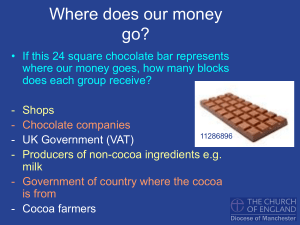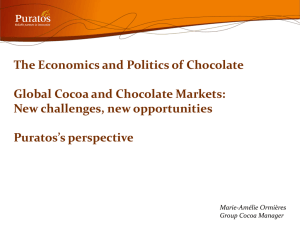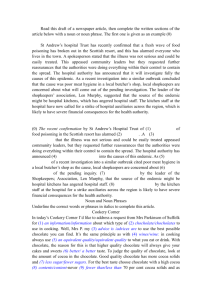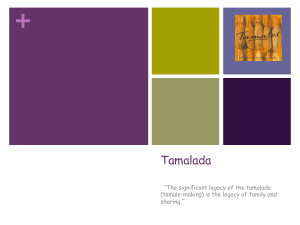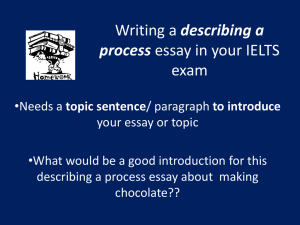Chocolate2-FromBeanToBar_LESSON_PLAN.doc
advertisement
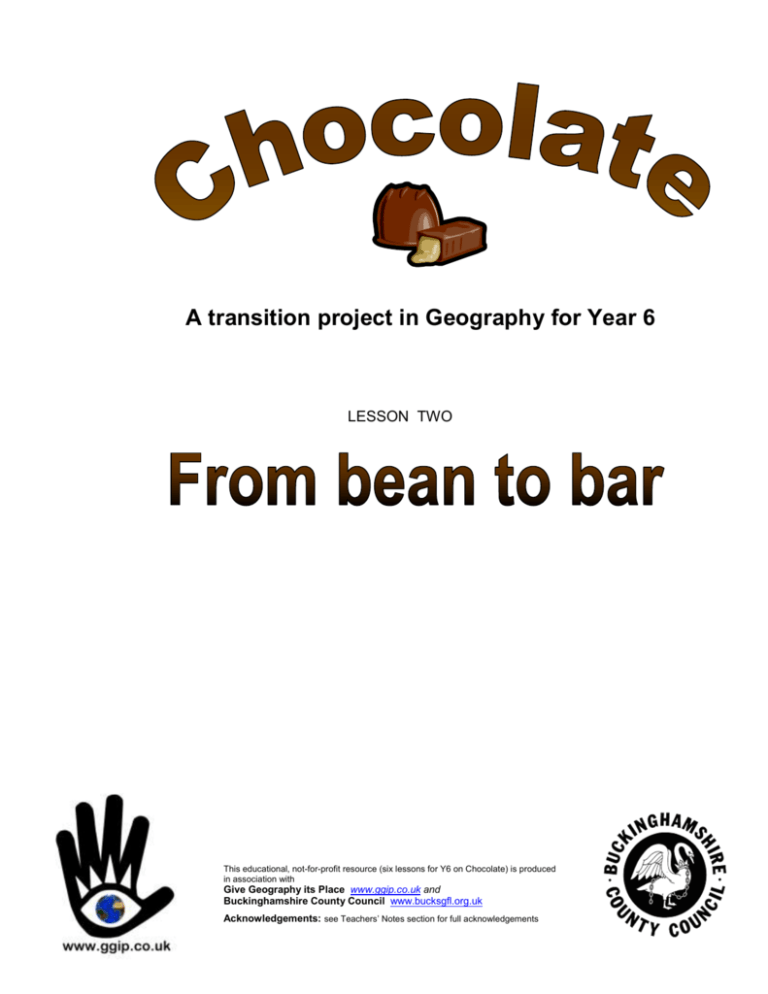
A transition project in Geography for Year 6 LESSON TWO This educational, not-for-profit resource (six lessons for Y6 on Chocolate) is produced in association with Give Geography its Place www.ggip.co.uk and Buckinghamshire County Council www.bucksgfl.org.uk Acknowledgements: see Teachers’ Notes section for full acknowledgements Introduction Timing Objectives Outcomes Activities This lesson involves looking at the chocolate journey from bean to bar One hour We Are Learning To: Link chocolate to the real people growing cocoa in Ghana Use photographs to find out what a place is like Sequence a series of images chronologically What I’m Looking For: Extended writing or informative display work to show the chocolate journey from bean to bar. Starter (5 mins) Give pairs of children a set of the 11 photo captions to read from 1B1 Ask them to read the caption and put them one under the other in the order they think the captions go. Main Activities (40 mins) Children check the order of their captions. If internet is available use the interactive photo sequence on the home page of the website http://www.papapaa.org/ks2/choc_1b.htm Show the images, discussing the extra facts as you go, and allow students to alter the sequence of their captions if required. If no internet is available, show correct sequence of images from the CD and photopack (£8 inc. p/p from the website) Where in the world is this? Find Ghana on atlases/globes Discuss: What can they tell about the lives of people who live here? What else do they want to know about? Divide the class into groups of three or four and give each group one of the photos. Ask the group to write down all the questions they can think of for their photo. If there are people in the photo, what do you think they might be saying or thinking? Give each person a speech bubble. Each group then shows its photograph in the correct order and tells the class what they think is happening there and questions they have Distinguish between three stages: 1. In Ghana 2. The journey 3. In Europe Follow-up with group or individual work as appropriate to the class (eg. display work, extended descriptive writing, a flow chart) Plenary: Big Facts Memory Game (15 mins) Look at the changing sequence of “Big Facts” on the www.papapaa.org Homepage or listed on “Additional Background” below. The sequence to take 3 minutes to scroll around on the website. Let the students read Extension Resources Key words Additional Background the Big Facts twice around, then have a collective memory exercise in groups. The children have the write down as many facts as they remember. (teacher keeps the group responses to use as a starter the following lesson) Children can read the extended information for each photo using sheets 1B2 or 1B3 and match the information to the photo captions. Or look at the extra image bank on Conacado Cocoa-growing cooperative and list difference between this and Mim village. KS2 resource sheets and full lesson plans from the PaPaaPaa website: Section One – Chocolate: Bean to Bar ~ 1B Bean to Bar – Additional lesson ideas ~ Photos 1-14 Mim Village, Ghana ~ 1B1 – Photo captions ~ 1B2 – Photo descriptions (and 1B3 – descriptions, short version) http://www.papapaa.org/ks2/choc_1b.htm ~ Photobank taken on a transect walk across a cocoa village in Ghana, reproduced with the permission of © Dan Raven-Ellison cocoa pod cutlass roasting fermentation weigh scales winnowing Equator Kuapa Kokoo cocoa butter Ghana Tema cocoa liquor harvest banana/plantain leaves conching The “Big Facts” There are about two million cocoa farmers in Ghana Cocoa farmers grow much of their own food, but they need cash to pay for many essentials such as school fees and doctor’s fees. Ghana: Average annual cocoa farmer’s income - £160 UK: Average annual pocket money - £166 Small scale farmers produce an average of 5 sacks of cocoa per year Cocoa likes constantly high temperatures and a lot of rain Cocoa farmers typically receive only 7p from a £1 bar of chocolate Ghanaian farmers formed Kuapo Kokoo in 1993 with 2000 members. Today there are more than 45,000 members in over 1000 villages Kuapo Kokoo means “good cocoa farmers” in the local language called Twi Their motto of “PaPaPaa” which means “best of the best” Day Chocolate is the only chocolate company whose producers also share in the ownership. Kuapo Kokoo own one third. Chocolate is not alone – there are more than 800 Fairtrade products on sale from fruit to footballs Sales of Fairtrade products in the UK continue to rise each year Two-thirds of all pocket money in the UK is spent on sweets and chocolate (Source British Council 2005) Every year in the UK we eat the equivalent weight of 71,579 London buses of chocolate. (That’s 500,000 tonnes!) We eat, on average, 16kg of chocolate a year, which means that we spend about £1.20 on chocolate a week A typical milk chocolate bar is made of cocoa mass and butter, milk, sugar and vegetable fat.

